Abstract
A comparative analysis of weaving performance of Bally Jute Company Ltd (BJCL) in pre- and post-COVID lockdown situation revealed the statistically significant difference in Hessian loom productivity. It was found that Hessian loom’s (finer quality fabric) kgs/loom/shift average daily efficiency and actual daily production were significantly different. In case of sacking loom (coarser quality fabric) however, there was no statistical difference in average daily kgs/loom/shift in actual production and loom efficiency. In case of S4 loom, statistically significant differences were observed in loom efficiency. It was further noted that average daily efficiency in kgs/loom/shift, number of loom running and actual daily production of both the Hessian and sacking quality loom were higher in pre-lockdown period compared to after the lockdown. These were due to shortage of manpower after the lockdown. A lot of labourers had returned to their home states of Bihar, Odisha and Uttar Pradesh. Absence of machine operators created problems to run the unit successfully with full capacity. This led to financial loss. In spite of demand for finished goods, the industry suffered loss of productivity in the post-lockdown period.
Research objectives
• To study the various weaving productivity parameters before and after lockdown.
• To analyse the collected data set of both the period.
• To find out the effect of lockdown, comparative analysis of both datasets.
Study area
To observe the effect of COVID-19 situation in productivity of jute industry, BJCL was selected. The unit is situated on the banks of river Hooghly in the district of Howrah close to Kolkata. It is well connected to rail and road networks. More than 3,000 employees are directly work there. Another 5,000 are indirectly linked with various jobs. Economy of the locality of Bally, Uttarpara, Belur, i.e, some parts of Howrah and Hooghly districts of West Bengal are dependent on the jute industry. Various fine fabrics of jute, bags, yarn of various range of count are the main products of this unit. The unit was closed from March 22 to second week of May last year due to lockdown. After that, it gradually began operations. This unit is representative of the jute industry in West Bengal.
Research methodology
In the pre-lockdown stage, the mill had registered production of the weaving department. The daily hard copy of computer-generated productivity report was available at the weaving department’s office. This data was collected and tabulated. Post-lockdown primary data of 25 days were studied and recorded in the productivity report register. The problems of lower productivity after lockdown stage and possible solutions to overcome them were brainstormed.
Literature review
The jute industry was under lockdown since March 23. Jute products are under Essential Commodities Act. So the supply of jute bags as packaging material for food grains should have continued to ensure uninterrupted supply. But the state government had put the jute industry under lockdown. At that time Rabi harvesting was under way and the requirement for jute bags was essential. Procurement agencies like the Food Corporation of India (FCI) and different state governments were suffering due to lack of jute bags. The jute industry in West Bengal, with its 2.5 lakh workers, was facing distress. With the boro crop approaching harvest, farmers were to face serious problems. A lot of the orders for jute bags were then diverted to the plastic industry, which had remained exempted from the lockdown [2].
However, farmers and agricultural workers prefer to store their produce in jute bags rather than in plastic ones as the former allow the produce to breathe. Thus, for procurement of food grains, availability of jute bales was immediately required by major procuring states like Punjab, Haryana, Uttar Pradesh (UP) and Madhya Pradesh, where procurement operations were scheduled to start in April. Further, the peak procurement period lasts for only about two to three weeks. Therefore, it was of utmost importance that jute mills immediately resumed operations for manufacturing and dispatching jute bales to meet the requirements. It was declared that 6.1 lakh bales of jute bags were required to meet the demands of the Rabi marketing season.
Due to pandemic, the demand for textile products and sale of domestic products reduced significantly. The textile business community faced cash crunch, supply chain disturbances and manpower-related issues. The mills did not incur raw material and electricity expenses but rest all expenses led to direct loss to the mill owners, who were under stress then to process material of semi-finished and finished products. All shipments were on hold. The labourers were in a dilemma whether to stay back or rush to their hometown, if the lockdown was lifted. Majority of them are migrants from Bihar, UP, Orissa etc. Most of the daily wage workers (nearly 80 per cent of the workforce of garment factories) went back to their hometowns. [3]
Results and discussions
Table 1 indicates the productivity status of weaving department of Hessian and sacking loom area. It was found that average efficiency of the machines of Hessian side was 57.41 per cent, whereas that of the sacking loom was 72.38 per cent from December 19, 2019 to January 14, 2020, i.e, before the lockdown. Table 3 shows the Hessian and sacking loom efficiency were 56.83 per cent and 72.24 per cent respectively after the lockdown. So no significant changes in efficiency percentage were observed during the two phases. In terms of kgs/loom/shift, Hessian and sacking loom were 36.41 kgs/loom/shift and 60.71 kg/loom/shift respectively before the lockdown. Maximum and minimum value of sacking loom was 89.42 kg and 58.16 kg before the lockdown. So a wide variation was observed in machine productivity.
From Table 3, it is found that the average productivity of Hessian and sacking loom were 34.18 kg/loom/shift and 58.96 kg/loom/shift respectively. It is quite on the lower side than what was observed during the pre-lockdown stage. The average number of looms before the lockdown was 570/day and 599/day, whereas after the lockdown, it was 529/day and 297/day for Hessian and sacking looms respectively. This figure is much lower than those in before the lockdown. Actual average production/day in July 2020 was much lower than that before the lockdown. That was because most of the employees had returned to their hometowns. External weavers came from other mills and worked regularly. Due to shortage of labourers, fewer looms were running, which led to lower production after the lockdown. So the pandemic had a substantial impact on productivity and machine efficiency of the weaving department.
Table 1: Daily production details of weaving department in pre-lockdown stage
Period: 19.12.19 to 14.1.20
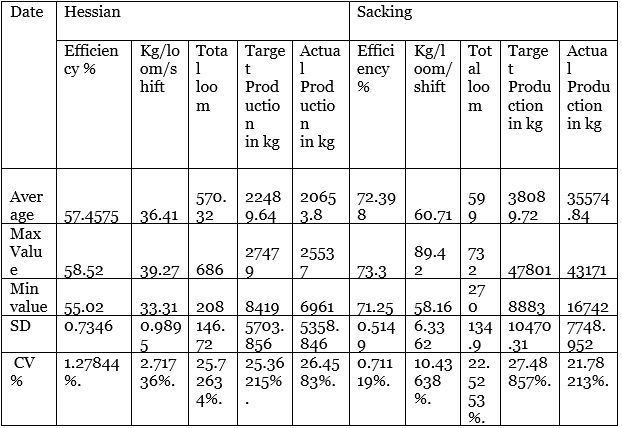
Source: Daily productivity report of mill
Figure 1: Variation of daily efficiency of Hessian and sacking quality in pre-lockdown period

Figure 1 shows that sacking loom efficiency was above 70 per cent efficiency line throughout the period and the Hessian loom daily average efficiency was less than 60 per cent in the pre-lockdown period.
Figure 2: Variation of sacking and Hessian loom kg/loom/shift in pre-lockdown study period
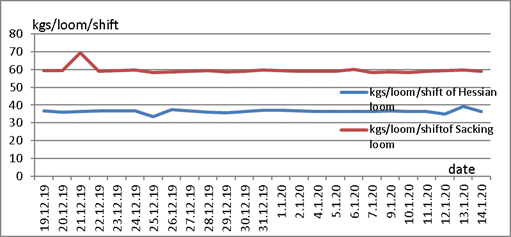
Figure 2 indicates that the kg/loom/shift of sacking loom were much higher than the Hessian loom. It is due to heavier cloth weight than Hessian fabric.
Table 2: Daily pre- and post-lockdown production details of weaving department
Period: 17.1.20 to 1.2.20 and 17.7.20 to 31.7.20)
|
Date Pre covid lock down |
S4 loom |
Broad loom |
Date Post covid lock down |
S4 loom |
Victor loom | ||||
|
Target Efficiency% |
Actual Efficiency % |
Target Efficiency% |
Actual Efficiency % |
Target Efficiency% |
Actual Efficiency % |
Target Efficiency% |
Actual Efficiency % | ||
|
Average |
75 |
61.69133 |
70 |
65.17533 |
Average |
75 |
64.06867 |
60 |
30.8 |
|
Max Value |
66.73 |
68.54 |
Max Value |
67.62 |
32.71 | ||||
|
Min value |
51.92 |
57.55 |
Min value |
62.14 |
32.8 | ||||
|
SD |
4.1829 |
2.8169 |
SD |
1.3363 |
2.138 | ||||
|
CV % |
6.78029%. |
4.322%. |
CV % |
2.08578%. |
6.22312%. | ||||
Source: Daily productivity report of the mill
Table 2 explains the productivity report of S4 loom. It was found that actual efficiency percentage in post-lockdown state is quite better than that in pre-lockdown state, in which, broad loom’s actual efficiency was 65.17 per cent. It was quite better. On some days, the actual efficiency of broad loom was quite close to the target value. After the lockdown, the broad loom section remained closed due to shortage of machine operators. Victor loom started production after the lockdown. It is a new department. Its average efficiency was 30.8 per cent, lower than the industry standard.
Figure 3: Variation of S4 and broad loom efficiency in pre-lockdown period
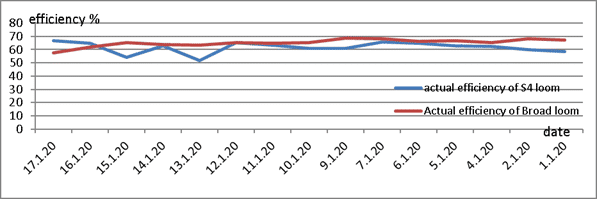
From Figure 3, we observe that the average daily Broad loom efficiency was gradually decreasing and at the end of the study period, the efficiency touched 60 per cent efficiency of pre-lockdown period. On the other hand, S4 loom efficiency was fluctuating. Finally, someday, the average day wise efficiency percentage was below 60 per cent.
Figure 4 Variation of S4 and Victor Loom Efficiency in post Covid 19 lockdown state on different days
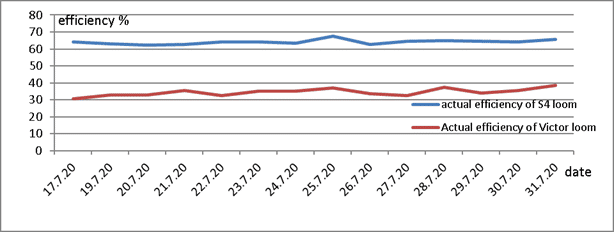
From Figure 4, We see that in post-lockdown stage, S4 efficiency/day was above 60 per cent and Victor loom efficiency percentage was above 30 per cent. Victor loom shade is new. It has just started with a few looms.
Table 3: Daily production details of weaving department in post-lockdown stage
Period: 6.7.20 to 31.7.20
|
Date |
Hessian |
Sacking | ||||||||
|
Efficiency % |
Kg/loom/shift |
Total loom |
Target Production in kg |
Actual Production in kg |
Efficiency % |
Kg/loom/shift |
Total loom |
Target Production in kg |
Actual Production in kg | |
|
Average |
56.83 |
34.18 |
529.44 |
20481.9 |
17667 |
72.24 |
58.96 |
297.5 |
19359.0 |
17544.64 |
|
Max Value |
60.43 |
36.04 |
647 |
24775 |
21908 |
74.31 |
60.65 |
407 |
26056 |
60.43 |
|
Min value |
55.08 |
33.25 |
217 |
8342 |
7152 |
71.22 |
58.13 |
117 |
7640 |
55.08 |
|
SD |
1.1631 |
0.7485 |
115.4409 |
4415.183 |
4147.381 |
0.7153 |
0.5842 |
71.593 |
4562.169 |
4392.523 |
|
CV % |
2.0464% |
2.1945% |
21.804% |
21.556% |
23.475% |
0.990%. |
0.9908% |
24.06% |
23.565% |
25.036% |
Source: Productivity report of the mill
Figure 5: Variation of daily efficiency of Hessian and sacking quality in post-lockdown period
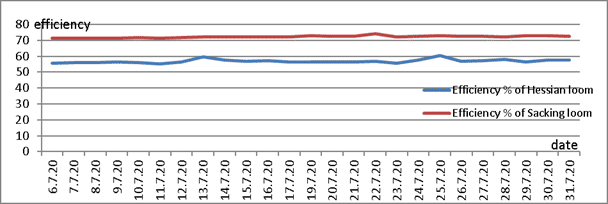
From Figure 5, we see that the sacking loom efficiency percentage was always higher than 70 per cent, whereas the Hessian loom daily average efficiency percentage was less than 60 per cent during the study period.
Table 4: Analysis of productivity parameters in pre- and post-lockdown period
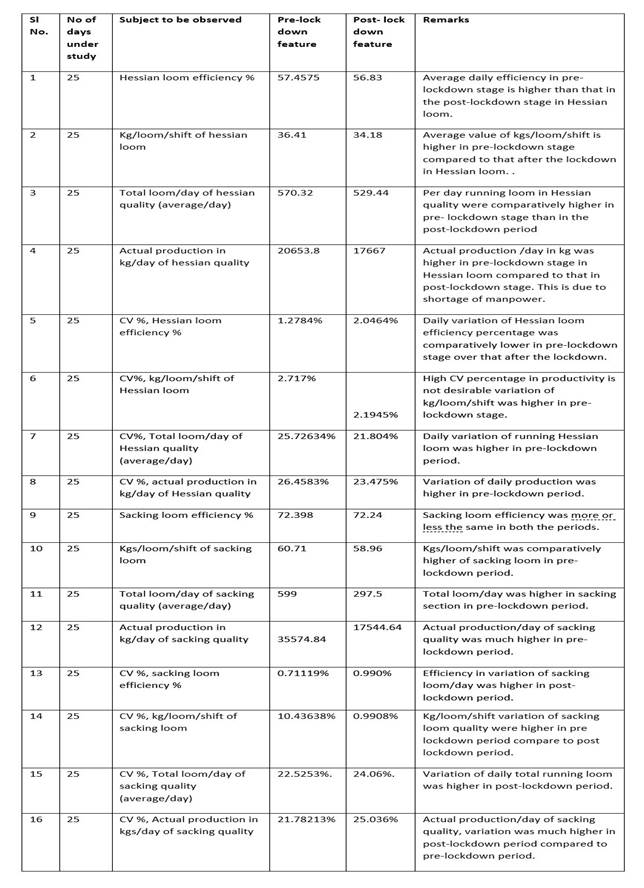
Table 5: Statistical analysis for observing the difference of productivity parameters in pre- and post-lockdown stages
|
Sl No |
Subject to be Hypothesis testing |
Value of N (No. of observation) |
Df |
Value of T |
Table value of two tail |
Comments |
Remarks |
|
1 |
H0 = There is No significant difference between, average value of Kg/loom/shift of Hessian looms between pre- and post-lockdown H1 = A significant difference exists. |
N=25 |
Df=N-1=24 |
9.28493 |
1.318 |
The t-value is 9.28493. Since the table value of t is less than the calculated value and the p-value is less than .00001. The result is significant at p < .05 |
H0 is rejected and H1 accepted, |
|
2 |
H0 = There is no significant difference between average value of kg/loom/shift of sacking looms between pre and post Covid lockdown. H1 = significance difference exists |
N=25 |
Df=N-1=24 |
1.37638 |
1.318 |
The t-value is 1.37638. The calculated value is higher than table value, so difference between the two parameters of sacking loom exist abut it is not statistically significant. The p-value is .175093. The result is not significant at p < .05. |
H0 is accepted and H1 is rejected. |
|
3 |
H0 = There is no significant difference between average value of actual daily production of Hessian looms between pre and post Covid lockdown. H1 = significant difference exist. |
N=25 |
Df=N-1=24 |
2.20386 |
1.318 |
The t-value is 2.20386. The calculated value is higher than the table value, so there is a significant difference between pre- and post- lockdown daily production. The p-value is .032364. The result is significant at p < .05 |
H0 is rejected and H1 is accepted. |
|
4 |
H0 = There is no significant difference between average value of actual daily production of sacking looms between pre- and post- lockdown periods. H1 = a significant Difference exists. |
N=25 |
Df=N-1=24 |
10.12 |
1.318 |
The t-value is 10.12099. The value of calculated t is higher than table value, so there is a significant difference between actual daily production of pre- and post- lockdown periods. The p-value is < .00001. The result is significant at p < .05 |
H0 is rejected and H1 accepted. |
|
5 |
H0 = There is no significance difference between efficiency value of Hessian looms between pre- and post- lockdown periods. H1 = significant difference exists. |
N=25 |
Df=N-1=24 |
-2.26515 |
1.318 |
The t-value is -2.26515. The calculated value of t 2.265 is higher than table value, so there is a difference of efficiency of Hessian looms between pre- and post-lockdown stages. The p-value is .014028. The result is significant at p < .05. |
H0 is rejected and H1 accepted. |
|
6 |
H0 = There is no significant difference between efficiency value of sacking looms between pre- and post-lockdown periods. H1 = A significant difference exists |
N=25 |
Df=N-1=24 |
0.84873 |
1.318 |
The t-value is 0.84873. The calculated value of t is less than the table value, so there is no significant difference between efficiency of sacking looms during pre- and post- lockdown stages. The p-value is .200121. The result is not significant at p < .05 |
H0 is accepted and H1 rejected. |
|
7 |
H0 = There is no significant difference between, efficiency value of S4 looms between pre- and post- lockdown periods. H1 = A significant difference exists. |
N=15 |
Df=N-1=14 |
-2.1 |
1.345 |
The t-value is -2.09681. The calculated t value of 2.1 is higher than table value, and so there is a difference of efficiency of S4 loom efficiency between pre- and post- lockdown stages. The p-value is .045167. The result is significant at p < .05. |
H0 is rejected and H1 is accepted. |
As seen from Table 5, in some cases, significant differences were observed in weaving productivity status in pre- and post-lockdown periods. The summary report of the T test is stated below:
|
Parameter |
Whether a significant difference was observed between pre- and post-lockdown periods? |
|
kg/loom/shift of Hessian loom |
Yes |
|
kg/loom/shift of sacking loom |
No |
|
actual daily production of Hessian loom |
Yes |
|
actual daily production of sacking loom |
No |
|
loom efficiency/day of Hessian loom |
Yes |
|
loom efficiency/day of sacking loom |
No |
|
loom efficiency/day of S4 loom |
Yes |
The unit is now coming back to normal. The top management has taken many corrective measures to run the unit with full capacity and has given priority to safety of workers.
References:
Green C, (June 2020), The impact of Covid-19 on employee productivity: Globant’s survey results, https://stayrelevant.globant.com.
Chattopadhyay S S [April 2020], Bengal jute mills wait for government nod to resume work and meet demand for sacks, https://frontline.thehindu.com.
Juneja A [April 2020], Coronavirus /Lockdown –impact on Textile Industry, www.textileassociationindia.org.
Panigrahi A, Ashutosh K, Mehta S and Pasricha S, (July 2020), Impact of coronavirus outbreak on Indian textile sector, Journal of Management Research and Analysis, 7(2):76-83.
Impact of COVID- 19 on Exports of Textile and Apparel Industry in Indian, (June 2020), https://textilevaluechain.in.
Juneja A, (April 2020), COVID-19 Lockdown: Impact on Textile Industry, https://www.fibre2fashion.com/industry-ar.
Singh S S, (April 15, 2020), COVID-19 lockdown | Bengal government allows operation of jute mills with 15% staff: www.thehindu.com/news/national.
Thakur J and Bhattacharya S, (April 22, 2020), Covid-19: 50 jute mills ask for permission to operate, only 5 get it in West Bengal, https://www.hindustantimes.com/kolkata.
Dutt I A and Acharya N, (November, 2019), Plastic's loss, jute's gain: Demand for 'golden fibre' boosts jute industry, https://www.business-standard.com/article/economy-policy.
Acharya N, (April 15, 2020), Covid-19: Jute mills seek more relaxation to meet Rabi packaging demand. https://www.business-standard.com/article/companies.
PTI, (March 28, 2020), COVID-19: Jute mills seek exemption to operate during lockdown, https://retail.economictimes.indiatimes.com/news/industry.
Logesh. M, Paul Mansingh J and Nisha A, (July 2020), Effect of COVID-19 Pandemic on the Market Price of Jute in India, https://www.agriculturejournal.org/volume8number2.
Singh G, (April 21, 2020), COVID-19 underlines crisis in jute mills in Kolkata suburbs, https://citizenmatters.in.



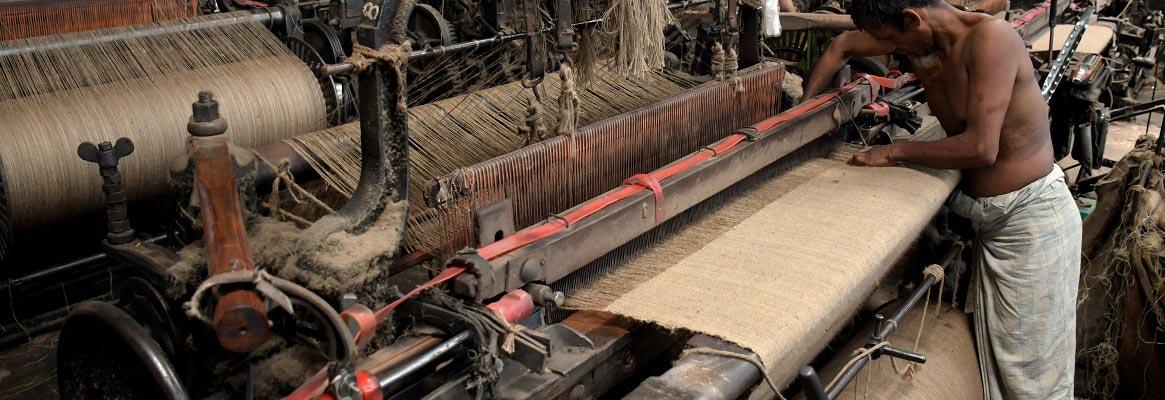



Comments